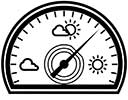Apiary Antics
After successfully performing artificial swarms for the first time in our beekeeping careers last weekend, this weekend we had to return to the hives to continue the process.
Although we had divided the colonies between two hives to produced a parent colony and a swarmed colony, the next step was to move the hive containing the parent colony in an attempt to prevent cast swarms being issued from it. The idea is that any new flying bees from the parent colony will return to their hive to find it gone and will then drift back to the hive containing the swarmed colony (now in the position of the original hive). This has two effects, it bolsters the number of bees in the swarmed colony, and reduces the number of flying bees in the parent colony thereby reducing the chances of it issuing another swarm.
Ynyslas Apiary
Of course, as usual all was not quite as planned. The colonies in the little apiary at our house were doing well. They seemed quiet and fairly happy. Bees were coming and going from all three and the hive re-location went as planned. The colony that has yet to swarm wasn’t showing any signs of swarming and the bees in the parent colony seemed fine from the outside. The swarmed colony still seemed quite ‘swarmy’ to us though. We managed to spot the queen, but there were also a few queen cells and lots of queen cups along the tops of the frames. As planned we destroyed the queen cells and hopefully they will settle down soon.
The hives at our house were also pretty low on stores so we fed them as well.
Out Apiary
By contrast the hives in our out apiary had loads of stores and were doing much better on that front – This is exactly as we had expected as the forage opportunities from the out apiary are far superior to those here in Ynyslas. All the same, it was good to see the contrast and to see that our thoughts on this matter were correct. There was certainly no need to feed the bees in the out apiary. The weather has changed today too and we’re in for a week (at least) of nice weather so hopefully the bees will be in full honey production mode and we’ll be beeding to add more honey supers soon.
Despite the improved fortunes of the bees in our out apiary, the inspection there wasn’t without its worries. Again, we moved the parent colony so as to hopefully prevent cast swarming. However, when we looked inside the swarmed colony, there was once again a number of dead bees in the gaps between the castellations and the side of the hive. We have no idea why there are so many dead bees, or why they end up in these gaps. We spotted the queen though and re-marked her as her marked had worn off, but we’re not really convinced of her vigour at the moment.
Whats up with out queen?
We also saw lots of drone brood in the super. We’re not sure how it got there as the queen was in the brood box below a queen excluder. Do we have laying workers in the supers? Is this due to the fact that the queen is failing? Should we try to re-queen the hive? What is going on? So many questions, but no definitive answers. I think it’s probably time to think about re-queening the colony, or at least to think about a strategy for doing so.
I’m tempted to take the queen out and create a nucleus from her that will act as an insurance policy. Then we could just let the hive re-queen itself. If they are successful we could destroy the original queen and reunite the bees from her nuc with the newly re-queened colony. If they are unsuccessful we can take some eggs from the nuc to give them another chance. The main issue with this is that at the moment there simply aren’t enough frames of bees in the colony to create a nuc from. Time for some reading to find out what to do.
They certainly keep us on our toes, busy bee-keepers as well as busy bees!











